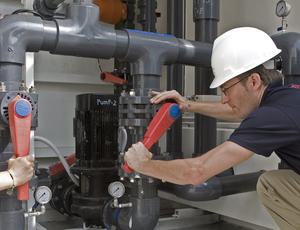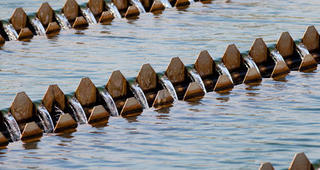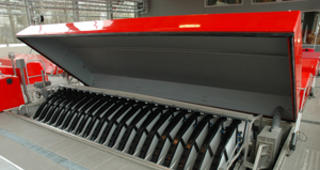The most compact solution for the biological removal of carbon and nitrogen.
Overview
Today municipalities are dealing with increasingly complex issues regarding their wastewater treatment. To meet these growing demands, here at Veolia Water Technologies, we are constantly innovating and adapting to meet ever-evolving needs.
Biostyr® Duo is the combination of two leading technologies: a biological aerated filter (BAF) and an AnoxKaldnes™ moving bed biofilm reactor (MBBR). Its standard design and engineering with fully-automated operation make it appropriate for municipal wastewater treatment application.
It is particularly suitable whenever compactness is sought since it can be retrofitted to expand a site’s footprint where there is limited space, such as cities where neighbors are nearby or in tourist and resort areas. It is also suitable for mountainous areas where, due to the more volatile climates, treatment installations have to be completely protected from bad weather. It is highly tolerant of process variations in load.
It can be used for secondary treatment, nitrification and denitrification.
How Biostyr Duo works
In the realm of biofiltration, Biostyr Duo is a third-generation innovation of biofilter technology.
It builds on the success of its predecessor Biostyr® — a compact solution for the treatment of carbon, chemical oxygen demand (COD), biochemical oxygen demand (BOD), nitrogen (NH4-N and NO3-N) and total suspended solids (TSS) — which is then combined with the proven K5 material in (moving bed biofilm reactor) from AnoxKaldnes, a subsidiary of Veolia Water Technologies.
The MBBR carriers are added to the Biostyrene which consists of polystyrene beads manufactured specifically and sized according to the application. These beads are blocked under the ceiling of the concrete structure (the cell) which is fitted with nozzles that allow the treated water to flow out.
The aeration manifold is located in the lower part of the structure and optimizes the contact time between the wastewater and the process air.
Biomass and suspended solids accumulated inside the physical filter media must be removed regularly by periodic backwashes. The lightweight material allows the system to be washed by simple gravity expansion of the filter media using the treated water stored in the upper structure (flushing). This results in less equipment being installed (no wash pump), less maintenance and better energy efficiency.

Features and benefits
- Compact process requiring no further clarification or filtration: small footprint.
- Modular design, therefore quick response to high load variations.
- Adaptable for different applications: carbon removal only; carbon removal and ammonia oxidation (nitrification); carbon removal and combined pre-denitrification, nitrification in separate structures; carbon removal and simultaneous nitrification-denitrification; tertiary nitrification, or tertiary denitrification with addition of a soluble carbon source, for example methanol.
- Downstream clarifiers or filters are not necessary, decreasing operation and maintenance requirements.
- Treated water of exceptional quality, even in very cold climates.
- No media escape from the process and no periodic replenishment or replacement of media required, decreasing maintenance costs.
- Does not require dedicated screening; typical headwork screens only.
- The only BAF working without chemically-enhanced primary treatment.
- Add-on nitrification and/or denitrification in one process with minimal space required.
- Fully automated sensor-based control process reducing maintenance.
Applications
Services
Resources & Product range
Biostyr® Pack
A response to market demands for a compact BAF system, suitable for installation within a restricted footprint with the ability to meet specific biological treatment demands including total nitrogen removal. Suitable for all process criteria and inlet flows between 8 and 1,200 cubic meters per hour.
Contact
With an increased population, many municipalities are facing the dilemma of needing to treat more wastewater but having limited land to build additional treatment facilities. This is compounded further by increasing quality regulations and the need to reduce the carbon footprint of operations. Biostyr Duo assures excellent effluent quality in the smallest space in a configuration that can reach almost 100 percent energy self-sufficiency.

Kim Sørensen
Senior Process and Technology Expert
Contact Kim through his LinkedIn account
FAQs about Biostyr® Duo
What is biofiltration?
Biofiltration processes, also known as BAFs, combine biological treatment, clarification and filtration into one compact system. The soluble pollution (i.e. carbon, nitrogen) is eliminated by the fixed biomass on growth support media. The effluent going through this media bed also eliminates particulate pollution (total suspended solids (TSS)). Usually built with multiple and parallel filter cells, it allows flexible and fully automated operational control, based on actual flow and load conditions.
What advantage does the addition of MBBR carriers in the Biostyr Duo bring to the classic Biostyr design?
The MBBR carriers occupy the previously empty space under the Biostyrene beads, thus increasing the biofilm surface available to enhance biological treatment in the same volume. This results in the even more compact nature of the Biostyr Duo technology. Also, the MBBR carrier layer prevents all biostyrene media loss during the backwash phase, separating the beads from the backwash water effluent.
Case Studies

The project focused on the renovation and wider performance improvement of the Biostyr cells of its Marne Aval plant which was built in 2009 and was reaching the 500,000 population equivalent capacity. There was also a focus on dealing with increasing pollution flows. Biostryr® Duo was selected to replace the entire biological stage. It has increased capacity and gives greater robustness during peak loads. It did not require any civil engineering work and allowed the plant to remain in operation throughout the work. It will generate operating, energy and reagent savings.

The first positive energy wastewater treatment plant in France. With Biostyr Duo it treats the wastewater of 160,000 inhabitants of the Symisca region, a syndicate grouping together the Nice Côte d'Azur metropolis and the municipalities of Cagnes-sur-Mer, La Colle-sur-Loup, Villeneuve Loubet and St-Paul-de-Vence. The mission was to increase purification performance and guarantee water treatment in compliance with European standards using a range of complementary, modular and efficient processes. It also transforms sludge into green energy by injecting biomethane into the grid network and valorizes the available heat and energy at each stage of its process.









